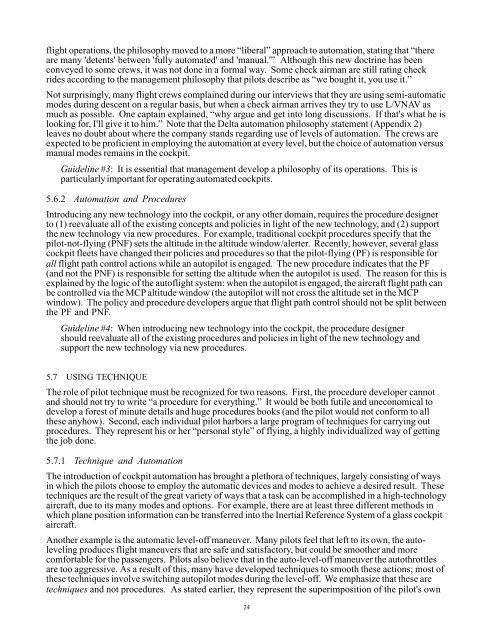On the Design of Flight-Deck Procedures - Intelligent Systems ...
On the Design of Flight-Deck Procedures - Intelligent Systems ...
On the Design of Flight-Deck Procedures - Intelligent Systems ...
You also want an ePaper? Increase the reach of your titles
YUMPU automatically turns print PDFs into web optimized ePapers that Google loves.
flight operations, <strong>the</strong> philosophy moved to a more “liberal” approach to automation, stating that “<strong>the</strong>reare many 'detents' between 'fully automated' and 'manual.'” Although this new doctrine has beenconveyed to some crews, it was not done in a formal way. Some check airman are still rating checkrides according to <strong>the</strong> management philosophy that pilots describe as “we bought it, you use it.”Not surprisingly, many flight crews complained during our interviews that <strong>the</strong>y are using semi-automaticmodes during descent on a regular basis, but when a check airman arrives <strong>the</strong>y try to use L/VNAV asmuch as possible. <strong>On</strong>e captain explained, “why argue and get into long discussions. If that's what he islooking for, I'll give it to him.” Note that <strong>the</strong> Delta automation philosophy statement (Appendix 2)leaves no doubt about where <strong>the</strong> company stands regarding use <strong>of</strong> levels <strong>of</strong> automation. The crews areexpected to be pr<strong>of</strong>icient in employing <strong>the</strong> automation at every level, but <strong>the</strong> choice <strong>of</strong> automation versusmanual modes remains in <strong>the</strong> cockpit.Guideline #3: It is essential that management develop a philosophy <strong>of</strong> its operations. This isparticularly important for operating automated cockpits.5.6.2 Automation and <strong>Procedures</strong>Introducing any new technology into <strong>the</strong> cockpit, or any o<strong>the</strong>r domain, requires <strong>the</strong> procedure designerto (1) reevaluate all <strong>of</strong> <strong>the</strong> existing concepts and policies in light <strong>of</strong> <strong>the</strong> new technology, and (2) support<strong>the</strong> new technology via new procedures. For example, traditional cockpit procedures specify that <strong>the</strong>pilot-not-flying (PNF) sets <strong>the</strong> altitude in <strong>the</strong> altitude window/alerter. Recently, however, several glasscockpit fleets have changed <strong>the</strong>ir policies and procedures so that <strong>the</strong> pilot-flying (PF) is responsible forall flight path control actions while an autopilot is engaged. The new procedure indicates that <strong>the</strong> PF(and not <strong>the</strong> PNF) is responsible for setting <strong>the</strong> altitude when <strong>the</strong> autopilot is used. The reason for this isexplained by <strong>the</strong> logic <strong>of</strong> <strong>the</strong> aut<strong>of</strong>light system: when <strong>the</strong> autopilot is engaged, <strong>the</strong> aircraft flight path canbe controlled via <strong>the</strong> MCP altitude window (<strong>the</strong> autopilot will not cross <strong>the</strong> altitude set in <strong>the</strong> MCPwindow). The policy and procedure developers argue that flight path control should not be split between<strong>the</strong> PF and PNF.Guideline #4: When introducing new technology into <strong>the</strong> cockpit, <strong>the</strong> procedure designershould reevaluate all <strong>of</strong> <strong>the</strong> existing procedures and policies in light <strong>of</strong> <strong>the</strong> new technology andsupport <strong>the</strong> new technology via new procedures.5.7 USING TECHNIQUEThe role <strong>of</strong> pilot technique must be recognized for two reasons. First, <strong>the</strong> procedure developer cannotand should not try to write “a procedure for everything.” It would be both futile and uneconomical todevelop a forest <strong>of</strong> minute details and huge procedures books (and <strong>the</strong> pilot would not conform to all<strong>the</strong>se anyhow). Second, each individual pilot harbors a large program <strong>of</strong> techniques for carrying outprocedures. They represent his or her “personal style” <strong>of</strong> flying, a highly individualized way <strong>of</strong> getting<strong>the</strong> job done.5.7.1 Technique and AutomationThe introduction <strong>of</strong> cockpit automation has brought a plethora <strong>of</strong> techniques, largely consisting <strong>of</strong> waysin which <strong>the</strong> pilots choose to employ <strong>the</strong> automatic devices and modes to achieve a desired result. Thesetechniques are <strong>the</strong> result <strong>of</strong> <strong>the</strong> great variety <strong>of</strong> ways that a task can be accomplished in a high-technologyaircraft, due to its many modes and options. For example, <strong>the</strong>re are at least three different methods inwhich plane position information can be transferred into <strong>the</strong> Inertial Reference System <strong>of</strong> a glass cockpitaircraft.Ano<strong>the</strong>r example is <strong>the</strong> automatic level-<strong>of</strong>f maneuver. Many pilots feel that left to its own, <strong>the</strong> autolevelingproduces flight maneuvers that are safe and satisfactory, but could be smoo<strong>the</strong>r and morecomfortable for <strong>the</strong> passengers. Pilots also believe that in <strong>the</strong> auto-level-<strong>of</strong>f maneuver <strong>the</strong> autothrottlesare too aggressive. As a result <strong>of</strong> this, many have developed techniques to smooth <strong>the</strong>se actions; most <strong>of</strong><strong>the</strong>se techniques involve switching autopilot modes during <strong>the</strong> level-<strong>of</strong>f. We emphasize that <strong>the</strong>se aretechniques and not procedures. As stated earlier, <strong>the</strong>y represent <strong>the</strong> superimposition <strong>of</strong> <strong>the</strong> pilot's own24
















